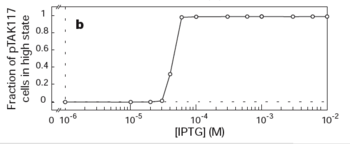Difference between revisions of "CellularMemory:Toggle Switch"
Wideloache (talk | contribs) (→Demonstration of the Toggle Switch) |
Wideloache (talk | contribs) (→Specific Biological Design) |
||
| (One intermediate revision by the same user not shown) | |||
| Line 8: | Line 8: | ||
==Specific Biological Design== | ==Specific Biological Design== | ||
| − | [[Image:TogglePlasmid.png|thumb|300px|right|'''Figure 1:''' Biological design of a genetic toggle switch | + | [[Image:TogglePlasmid.png|thumb|300px|right|'''Figure 1:''' Biological design of a genetic toggle switch]] |
| − | Figure 1 on the right shows the specific configuration of the | + | Figure 1 on the right shows the specific configuration of the plasmid constructs that were used in this paper. Two different plasmids were created, each of which confers cellular memory. The plasmids consist of two promoter/repressor pairs, one of which is the P<sub>trc</sub> promoter and the lacI repressor (inhibited by IPTG). P1 and R1 represent the second promoter/repressor pair that was used in conjunction with P<sub>trc</sub> and lacI. Plasmids with the P<sub>L</sub>s1con promoter and the temperature sensitive lambda repressor as their second promoter/repressor pair were referred to as pTAK constructs. Plasmids with the P<sub>L</sub>tetO-1 promoter and the tetR repressor (inhibited by aTC) were referred to as pIKE constructs. Multiple types of each plasmid design were constructed by modifying the ribosomal binding site strength of the repressor genes. The constructs were capable of toggling between “on” and “off” stable steady states of GFP production through exposure to a repressor-inhibitor (IPTG, 42 degrees C, or aTc). In this way, the plasmids were able to “remember” the most recent inhibitor that was in their environment |
[[Image:linebreak.png]] | [[Image:linebreak.png]] | ||
| Line 17: | Line 17: | ||
==Results== | ==Results== | ||
===Measuring the Toggle Point=== | ===Measuring the Toggle Point=== | ||
| − | [[Image:TogglePoint.png|thumb|350px|right|'''Figure 2:''' Measuring the IPTG toggle-point concentration | + | [[Image:TogglePoint.png|thumb|350px|right|'''Figure 2:''' Measuring the IPTG toggle-point concentration.]] |
The toggle-point of the plasmids was first investigated to determine the amount of input that must be detected by a cell for a toggle to occur. This was looked at specifically for IPTG. Figure 2 shows that a step-like toggle occurs at an IPTG concentration between 10<sup>-4</sup> and 10<sup>-5</sup> M. Based on this data, 100% of the cells should “remember” an IPTG concentration >10<sup>-4</sup> M, while a concentration below this will cause none or a portion of the cells to toggle. Similar measurements were done for aTc concentration and lambda repressor temperature sensitivity. | The toggle-point of the plasmids was first investigated to determine the amount of input that must be detected by a cell for a toggle to occur. This was looked at specifically for IPTG. Figure 2 shows that a step-like toggle occurs at an IPTG concentration between 10<sup>-4</sup> and 10<sup>-5</sup> M. Based on this data, 100% of the cells should “remember” an IPTG concentration >10<sup>-4</sup> M, while a concentration below this will cause none or a portion of the cells to toggle. Similar measurements were done for aTc concentration and lambda repressor temperature sensitivity. | ||
[[Image:linebreak.png]] | [[Image:linebreak.png]] | ||
| Line 23: | Line 23: | ||
===Demonstration of the Toggle Switch=== | ===Demonstration of the Toggle Switch=== | ||
The pTAK and pIKE constructs were then tested for the ability to toggle between the on and off states. In Figure 3, below, the top row of boxes a and b represent the experimental results for the different plasmid types. The bottom two rows of boxes a and b are controls, which behave as expected. All of the cells were set to the on state though 6 hours of exposure to IPTG. All but one (pIKE105) of the experimental constructs remained in the on state after removal of IPTG. The promoter and repressor strength were likely not well-balanced in the pIKE105. The cells were then exposed to a second input (42 degrees C or aTc), causing them to toggle into the off state and remain off even when the input was removed. In this way, it was demonstrated that both toggle switch constructs were capable of "remembering" their most recent environmental condition and modifying GFP production based on this memory. | The pTAK and pIKE constructs were then tested for the ability to toggle between the on and off states. In Figure 3, below, the top row of boxes a and b represent the experimental results for the different plasmid types. The bottom two rows of boxes a and b are controls, which behave as expected. All of the cells were set to the on state though 6 hours of exposure to IPTG. All but one (pIKE105) of the experimental constructs remained in the on state after removal of IPTG. The promoter and repressor strength were likely not well-balanced in the pIKE105. The cells were then exposed to a second input (42 degrees C or aTc), causing them to toggle into the off state and remain off even when the input was removed. In this way, it was demonstrated that both toggle switch constructs were capable of "remembering" their most recent environmental condition and modifying GFP production based on this memory. | ||
| − | [[Image:ToggleResults.png|thumb|400px|center|'''Figure 3:''' Experimental results for a) pTAK and b) pIKE plasmids | + | [[Image:ToggleResults.png|thumb|400px|center|'''Figure 3:''' Experimental results for a) pTAK and b) pIKE plasmids.]] |
[[Image:linebreak.png]] | [[Image:linebreak.png]] | ||
Latest revision as of 18:09, 14 December 2007
Main Page | Biological Designs | Mathematical Models | Toggle Switch | Hysteresis | Permanent Memory | Conclusions | References
|



